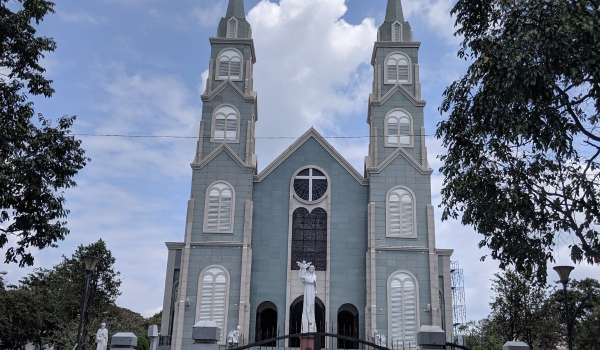
In a land area of 1,975.2 square kilometers, the diocesan territory covers Ba Ria - Vung Tau province that is comprised of the coastal Vung Tau City, Ba Ria Town and six subdistricts of Chau Duc, Con Dao, Dat Do, Long Dien, Tan Thanh and Xuyen Moc. The diocese is bounded in the north by Xuan Loc diocese, in the northeast by Phan Thiet diocese, in the southeast by the East Sea and in the west by Ho Chi Minh City archdiocese. Furthermore, the diocese is bounded by 100 kilometers of sea.
As of yearend 2009, the total poulation of Ba Ria - Vung Tau province was 994,837 including ethnic groups of Chau Ro, Chinese, Muong and Tay. 23.24 percent of the population is Catholics.
Vietnamese is the official language used in the province. Local ethnic groups still speak their own languages within their communities.
Diocese of Ba Ria (Dioecesim Barianensem)
Created: Nov. 22, 2005
Suffragan of Ho Chi Minh City Archdiocese
Titular: Mary Mother of God
Ba Ria diocese was carved out from Xuan Loc diocese on Nov. 22, 2005 and then Auxiliary Bishop Thomas Nguyen Van Tram was named as the first bishop of the youngest diocese in the country.
Catholics and foreign missioners moved from other places to this area to avoid religious persecution in 1630-1665. Later they erected many parishes existing today. Hundreds of local Catholics bravely died for Catholic faith during religious persecution by Nguyen Dynasty soldiers in the 19th century. In August 1861, about 700 local Catholics were detained in prisons of Dat Do, Long Dien, Long Tan and Phuoc Le. In the evening of Jan. 7, 1862, when French troops attacked Ba Ria, soldiers fled and set fire to those four prisons, leaving 288 men, 102 women and 54 children under the age of 10 dead.
The Tomb of Martyrs Church built on the foundation of Phuoc Le prison in 1865 nearby the cathedral is a famous religious site today.
The six-year-old diocese consecrated the Mary Mother of God Cathedral in 2010 and plans to build other Church facilities -- the bishop's house, a pastoral center and seminary. Training priests, Religious, lay leaders, catechists and Caritas workers is also top priority of the local Church. Local Catholics provide medical care, build houses for poor people, take care of disabled children, bury aborted fetuses and work with migrant workers.
The diocese is also well known for its religious sites attracting people from other places.
Giant Statue of Christ the King in the southern coastal city of Vung Tau attracts thousands of people for prayer as well as sightseeing. The 32-meter-tall statue of Jesus with arms outstretched faces the Pacific Ocean from the summit of Mount Tao Phung, 176 meters above sea level. The statue?s arms span 18.4 meters, welcoming visitors to crowded sandy beaches in the city. The statue, erected by hundreds of thousands of local Catholics with sand, pebbles and stones taken from many places in the country, was completed in 1975 and consecrated on Dec. 2, 1994. From the street, at the base of the hill, visitors climb almost 1,000 stone stairs to the statue. Along the way, they can stop at a resting place with coffee and buy souvenirs sold by Lovers of the Holy Cross Sisters. The resting place is full of flowers and angel statues.
Around the foot of the Christ statue are 50 stone benches where visitors can sit and pray and enjoy the panoramic view. Sculptures of Jesus and Saint Peter, the Last Supper and the crucified Jesus encircle the pedestal. Further down is a big white replica of the Pieta, the famous statue attributed to Michelangelo, of Mary holding the crucified Jesus. Inside the giant statue is a shop selling Catholic items and a spiral staircase with 133 stairs leading to the statue?s hands. Up to six people can stand inside each hand and enjoy the view from there through a window. People like the panoramic view of the sea, city, mountains and fields from the arms of the statue.
Bai Dau Pilgrimage Center, a Marian pilgrim shrine, is nearby the giant statue of Christ the King. The 32-meter-high statue of Mother of God standing on the side of a hill, 60 meters above sea level, was inaugurated on Dec. 31, 1994. A Marian shrine with a seating capacity of 1,000 was inaugurated on July 22, 1995. 14 Stations of the Cross with 3-meter-high statues and 2.5-meter-high statues of 20 Mysteries of the Rosary stand along a winding path on the mountain side. Pilgrims attend Eucharist adoration all day at a dome-shaped chapel of Vietnamese Martyrs keeping relics of 71 Martyrs.
Dozens of congregations and societies have set up communities around the shrine in a popular beach area of Vung Tau town, 125 kilometers east of Ho Chi Minh City. They provide lodging and food for pilgrims and tourists.
The area has a temperate tropical climate. It has two seasons - the dry season from November to April and the rainy season from May to October. The annual average temperature is 25-27 degrees centigrade.
The province's annual per capita income in 2010 was US$5,800, four times higher than the country's annual per capita income.
Vung Tau city, the center of oil and gas industry, is one of the wealthiest cities in the country. Its economy is also concentrated on tourism services, agricultural products and seafoods.
The province has followers of Buddhism, Catholicism, Protestanism and the indigenous faith of Cao Dai.